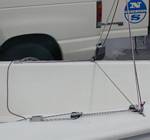
This was contributed by Ethan Bixby # 5271 of FL. His email address appears at the end of the article. Thanks Ethan!
My goals with the traveler are to maximize the control over the tension applied to the headstay via the mainsail and accurate control of the mainsail leech tension. Both factors affect pointing and balance upwind.
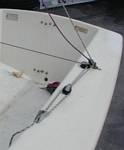 I have constructed a fairly simple traveler system. Photo
#1(wmtrave.jpg) and Photo #2 (wmtrav1.jpg) illustrate these
working parts. I left the cleats on the tanks, as they were
already there. They could easily be brought further forward if
desired.
I have constructed a fairly simple traveler system. Photo
#1(wmtrave.jpg) and Photo #2 (wmtrav1.jpg) illustrate these
working parts. I left the cleats on the tanks, as they were
already there. They could easily be brought further forward if
desired.
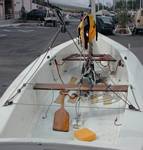 The "centering" line effectively limits both port and
starboard side centering line equally. So when the bridal line
(other control) is slack, the centering line holds the turning
block on the centerline. See photo #3. (wmtravd.jpg)
The "centering" line effectively limits both port and
starboard side centering line equally. So when the bridal line
(other control) is slack, the centering line holds the turning
block on the centerline. See photo #3. (wmtravd.jpg)
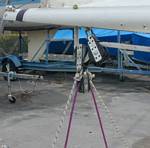 In light air, I set the centering line to hold the block just
below the boom. This ensures that I can centerline the boom with
the most open leech (low sheet tension) possible. As the wind
increases, I need to sheet a little harder so I tension the
centering line a little to lower the block. Generally, I leave a
little room so that I can sheet the mainsail in a bit if an extra
bit of pointing is needed for a short time.
In light air, I set the centering line to hold the block just
below the boom. This ensures that I can centerline the boom with
the most open leech (low sheet tension) possible. As the wind
increases, I need to sheet a little harder so I tension the
centering line a little to lower the block. Generally, I leave a
little room so that I can sheet the mainsail in a bit if an extra
bit of pointing is needed for a short time.
As it gets windier and I need to ease the mainsheet to keep the boat flat, I tension the bridal line to the point where it draws tight and the leeward centering line goes slack. As you ease the centering line, the mainsheet block will drop further to leeward, and you can sheet harder but off center. The sheet tension keeps the main flatter and the twist in control, yet the outboard position of the boom keeps the heeling minimized, and you can keep the boat flat. Sailing the boat nearly flat upwind is a major key to upwind speed.
From this point, you balance the position of the block to keep you in a range that allows you to keep mainsheet tension on in the lulls and pointing conditions, and ease the sheet a little for the when overpowered in the puffs or for footing conditions.
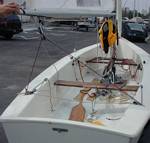 If you tend to ease the jib halyard to rake back and de-power the
rig as the breeze builds, then you can adjust the bridle line to
match the height of the boom. When it is really windy and you are
way overpowered, the bridle line is low and the main block is very
close to the inside edge of the deck. See photo #4 (wmtravb.jpg)
If you tend to ease the jib halyard to rake back and de-power the
rig as the breeze builds, then you can adjust the bridle line to
match the height of the boom. When it is really windy and you are
way overpowered, the bridle line is low and the main block is very
close to the inside edge of the deck. See photo #4 (wmtravb.jpg)
Hope that this helps you keep your 'Mill going fast and easy in a big breeze! If you have any questions or comments, you can email me at Ethan Bixby
07/15/2002